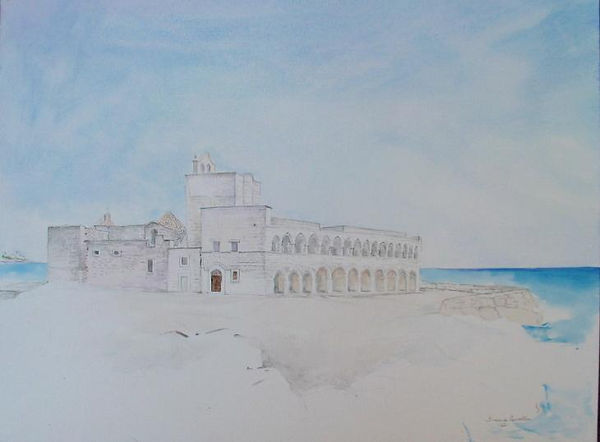José F. Grave de Peralta

Page Title
P u g l i a:
Castles and cathedrals
Along with its sunlight and the soft-spoken manner of its people, the castleand cathedral architecture of Puglia tell a story that stays glued to one's pupils long after the instant of their vision. I owe my discovery of Puglia to an invitation by dear Chilean friends Doris and Fernando, working and living in Rome, to visit them in Gallipoli a few summers ago

The cathedral of Trani in the Italian region of Puglia was built on top of a small, previously existing shrine dedicated at the end of the 1000s to St. Nicholas the Pilgrim (San Nicola il Pellegrino), the patron saint of this beautiful Adriatic port. Nicola's relics are kept in a coffer under the shrine's altar. Medieval legends, not unlike those of Arion in Greek mythology, tell of a young Christian pilgrim from Tyre, whose ship capsized on the way to Italy, causing the young man to almost drown, had it not been for a dolphin that miraculously brought him to safety onto the shores of Trani. According to the stories, Niccola would go around the city
singing "Kyrie eleison" (Lord have mercy) and giving gifts to children. Only a few months later, however, he took ill and died, but soon the aura of his story with the dolphin and several miracles attributed to him won him his halo.

The cathedral of the Sea : TRANI
watercolor

The monastery of La Colonna one of of Trani's most lovely capes was the home of a small community of Benedictine monks back in the years 1000's. The architecture of this and other Tranian buildings dating back to those times reflects the style of the Norman dukes and lords who had invaded Italy (Puglia) at that time -- with a mixture of Greek and Middle Eastern characteristics as well. In the 1400s, the monastery housed a wooden crucifix that had bled, according to the area histories, when a Saracen corsaire had struck it with his sword in disbelief.


Torre aragonesa in Santa Maria di Leuca (PUGLIA)
color pencil

Church of Sant'Andrea in Trani
pencil.....and ....watercolor
The Cathedral of Ruvo di Puglia
pen & ink

When I was barely beginning to pencil in the above watercolor of Sant Andrea Church, during my recent sketching trip to Puglia, the then-sindaco (mayor) of Trani, Dr. Giuseppe Tarantini, stopped to chat with me . The mayor kindly informed me that the church was originally named Santa Trinità (Holy Trinity) and that the temple's three cupolas numerically signified this kinship of Father-Son-Holy Spirit by the fact that the form of the first was a 4-sided polygon, that of the second an octagon, and the third a dodecahedron.


This page of historical studies in pencil, ink pen, and watercolor palette throughout the sunlit region of PUGLIA would not be complete without showing several drawings of the many castles from the period of the "Stupor Mundi," or wonder of the world emperor (as Dante calls him in The Divine Comedy) Federico II.
In his early-13th century court in these regions --most likely-- the first steps were taken philosophically, politically, and in dance and song, to bring about the huge change of vision that we call the Renaissance.
One of the most evocative of these Frederick castles is the OCTOGONAL observatory he built not far from Trani, in a site appropriately called Castel del Monte.
In many ways, my encounter through books with this Norman-Germanic emperor of Italian history was one of the strongest forces that pulled me to come live in Italy. The story of how this Emperor effected a huge turn-around in the Third Crusade by making friends with the Islamic Caliph in Jerusalem, thereby earning for himself excommunication by his former ally the Pope of Rome, made a poignant narrative counterpoint to the legends about his inviting St. Francis of Assisi to visit him in the Octagonal Castle. Supposedly saint and sinner dined, wined, and exchanged views late into the starry night of these still remote Puglian lands.